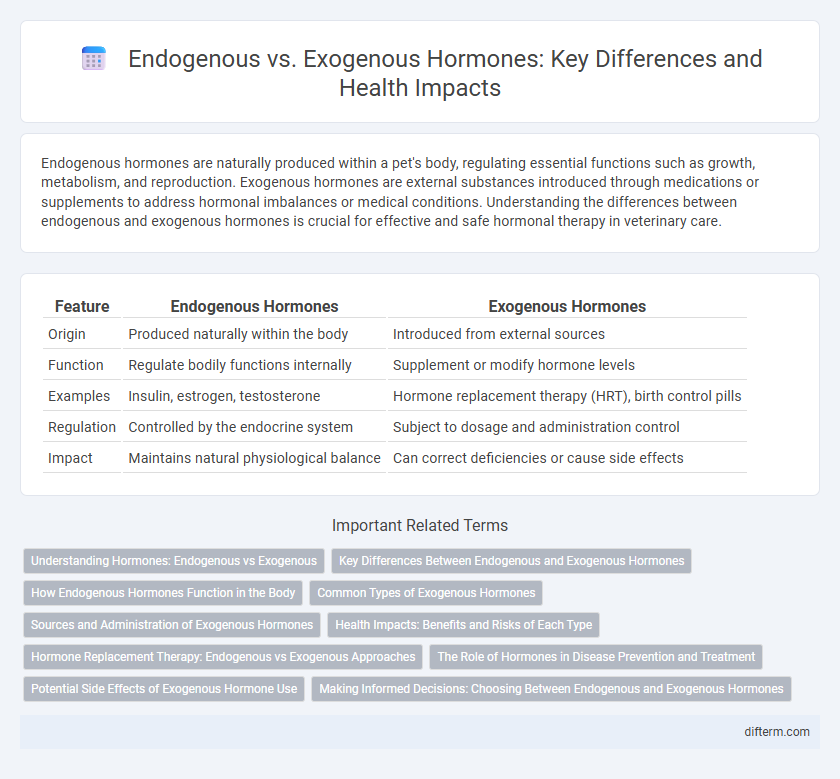Endogenous hormones are naturally produced within a pet's body, regulating essential functions such as growth, metabolism, and reproduction. Exogenous hormones are external substances introduced through medications or supplements to address hormonal imbalances or medical conditions. Understanding the differences between endogenous and exogenous hormones is crucial for effective and safe hormonal therapy in veterinary care.
Table of Comparison
| Feature | Endogenous Hormones | Exogenous Hormones |
|---|---|---|
| Origin | Produced naturally within the body | Introduced from external sources |
| Function | Regulate bodily functions internally | Supplement or modify hormone levels |
| Examples | Insulin, estrogen, testosterone | Hormone replacement therapy (HRT), birth control pills |
| Regulation | Controlled by the endocrine system | Subject to dosage and administration control |
| Impact | Maintains natural physiological balance | Can correct deficiencies or cause side effects |
Understanding Hormones: Endogenous vs Exogenous
Endogenous hormones are naturally produced by glands within the body, regulating key physiological processes such as growth, metabolism, and reproduction. Exogenous hormones originate outside the body, introduced through medications or therapies like hormone replacement therapy, impacting hormone balance and function. Understanding the differences between endogenous and exogenous hormones is crucial for effective diagnosis and treatment of endocrine disorders.
Key Differences Between Endogenous and Exogenous Hormones
Endogenous hormones are naturally produced within the body by glands such as the pituitary, thyroid, and adrenal glands, regulating physiological processes like metabolism, growth, and reproduction. Exogenous hormones are synthetic or bioidentical substances introduced from outside the body, commonly through medications or hormone replacement therapies. Key differences include origin, regulation mechanisms, and potential side effects, with endogenous hormones maintaining homeostasis and exogenous hormones posing risks of imbalances and adverse reactions.
How Endogenous Hormones Function in the Body
Endogenous hormones are biologically produced within the endocrine glands, regulating vital bodily functions such as metabolism, growth, reproduction, and mood. These hormones operate through feedback mechanisms that maintain homeostasis by signaling target organs via bloodstream transport. Their precise secretion and receptor interaction ensure optimal physiological balance and adaptive responses to internal stimuli.
Common Types of Exogenous Hormones
Common types of exogenous hormones include synthetic estrogens, progestins, and androgens used in hormone replacement therapy and contraceptives. Exogenous thyroid hormones, such as levothyroxine, are prescribed to manage hypothyroidism by supplementing insufficient endogenous production. Corticosteroids like prednisone, often administered to reduce inflammation, mimic the function of naturally produced adrenal hormones.
Sources and Administration of Exogenous Hormones
Exogenous hormones are synthetic or natural hormones introduced into the body through various administration routes, including oral tablets, transdermal patches, injections, and topical gels. Common sources of exogenous hormones include pharmaceutical formulations of estrogen, progesterone, testosterone, and corticosteroids used in hormone replacement therapy, birth control, and treatment of endocrine disorders. These hormones bypass endogenous production by the body's endocrine glands, providing targeted regulation of hormone levels for therapeutic purposes.
Health Impacts: Benefits and Risks of Each Type
Endogenous hormones, produced naturally within the body, regulate essential functions like metabolism, growth, and mood, promoting overall health balance but can cause disorders if imbalanced. Exogenous hormones, introduced through medications or supplements, can effectively treat conditions such as hormone deficiencies and menopause symptoms but carry risks including hormone dependency, cancer, and cardiovascular issues. Understanding the specific context, dosage, and individual health status is crucial for optimizing the benefits while minimizing the risks associated with both hormone types.
Hormone Replacement Therapy: Endogenous vs Exogenous Approaches
Hormone replacement therapy (HRT) involves administering exogenous hormones to compensate for deficiencies in endogenous hormone production, primarily targeting estrogen, progesterone, and testosterone levels. Endogenous hormones are naturally synthesized within the body by glands such as the ovaries, testes, and adrenal glands, while exogenous hormones are derived from external sources and tailored to mimic or supplement natural hormone activity. Understanding the differences between these hormone sources is crucial for optimizing HRT protocols, minimizing side effects, and improving patient outcomes in conditions like menopause, hypogonadism, and endocrine disorders.
The Role of Hormones in Disease Prevention and Treatment
Endogenous hormones, produced naturally by the body, regulate critical physiological processes that maintain homeostasis and support immune function, playing a vital role in disease prevention. Exogenous hormones, administered externally through medications or therapies, are utilized to correct hormonal imbalances, manage chronic conditions, and aid in the treatment of endocrine disorders such as diabetes, thyroid dysfunction, and hormone-sensitive cancers. Understanding the distinct mechanisms and effects of endogenous versus exogenous hormones enables targeted therapeutic strategies that improve patient outcomes and reduce disease progression.
Potential Side Effects of Exogenous Hormone Use
Exogenous hormone use can lead to a range of potential side effects including hormonal imbalances, increased risk of cardiovascular disease, and liver toxicity. Prolonged exposure to synthetic hormones may disrupt natural endocrine functions, causing symptoms such as mood swings, weight gain, and reproductive issues. Close medical supervision is essential to monitor for adverse reactions and adjust dosages to minimize health risks.
Making Informed Decisions: Choosing Between Endogenous and Exogenous Hormones
Understanding the differences between endogenous and exogenous hormones is crucial for making informed healthcare decisions, as endogenous hormones are naturally produced by the body, while exogenous hormones are introduced externally through medications or therapies. Evaluating factors such as hormone type, dosage, potential side effects, and individual health conditions enables patients and healthcare providers to tailor hormone therapies effectively. Prioritizing personalized treatment plans ensures optimal hormonal balance and minimizes risks associated with hormone replacement or supplementation.
Endogenous vs Exogenous Hormones Infographic

 difterm.com
difterm.com